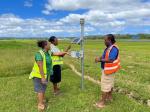Global meteorological links making a difference at home and abroad
23 March 2023
The Earth's atmosphere operates outside of political and geographical boundaries. Meteorology is a global science that moves forward through partnerships and collaboration. The Bureau works with partners in other countries, sharing information and resources to benefit people in Australia and around the world.
World Meteorological Day is celebrated each year on 23 March. It's an opportunity to recognise the essential daily contributions that national weather and water agencies make. It's also a time to consider how global cooperation helps us deliver our local services.
Video: Watch this short video to find out more about how global collaboration supports local forecasts and warnings.
Working with Pacific partners to improve observations
Australia has committed to supporting the Weather Ready Pacific initiative under the Pacific Meteorological Council. This project will enhance early warning systems and increase climate resilience in the Pacific region.
We'll provide the technical guidance and advice that the Pacific needs to improve its infrastructure, systems and training. This will make every nation in the region safer from severe weather.
'Severe weather events have devastating impacts on Pacific Island communities. It causes loss of life and damage to homes and infrastructure, agricultural lands, livelihoods, and economies,' General Manager of International Development, Dr Andrew Jones said.
'Communities are more vulnerable to extreme events as climate change increases their intensity and frequency.'
.png)
Image: Weather Ready Pacific in action: Vanuatu Meteorology staff with observations equipment at Bauerfield International Airport in Port Vila.
The Bureau has been a member of the World Meteorological Organization since its establishment in 1950. One of our roles is as a peer advisor in the Systematic Observations Financing Facility (SOFF).
We partner with key meteorological agencies in the Pacific region – Fiji, Kiribati, Samoa and the Solomon Islands. We bring our world-leading capabilities to help design solutions to support the safety, security and livelihoods of our neighbours.
The SOFF project focuses on funding improvements to atmospheric and marine observations. These are a fundamental element to improving weather and climate services, and early warnings for all.
.png)
Image: Bureau CEO Dr Andrew Johnson signs the SOFF agreement at the World Meteorological Organization in Geneva, Switzerland
Sharing satellites
Surrounded by vast expanses of ocean, Australia relies on observations from land, oceans and satellites to observe the weather over this enormous region. This includes observations from other nations.
Thanks to our World Meteorological Organization membership, we have free access to data from around 30 satellites, operated by Europe, the US, Japan, India, and others.
'The Bureau has an especially close relationship with the Japan Meteorological Agency which goes back decades,' Agnes Lane, National Space Mission for Earth Observations program manager said.
'We receive data from Japan's Himawari satellite every 10 minutes. But as part of a special arrangement with Japan, we can also request data every two and a half minutes. We use this during natural disasters – not just for Australia but for the whole Pacific region.'
The Bureau uses satellite data from our international partners for weather forecasts and warnings, as well as in the advice we provide to the Australian community and emergency services every day.
Our meteorologists also provide tailored advice to key stakeholders. These include the aviation and maritime sectors, state emergency services and cultural events, such as sport and festivals.
.png)
Image: Senior meteorologist Keris Arndt providing forecast advice at the Australian Open in January 2023.
Each year, we deliver approximately 700,000 public forecast services, 1.98 million aviation forecast products, more than 500,000 climate graphs and charts, 175,000 marine safety broadcasts and 19,000 weather and ocean warnings.
Since July 2021, we've issued more than 6200 flood products and 6000 thunderstorm and severe weather warnings. We've also delivered hundreds of briefings to our emergency service partners.



Comment. Tell us what you think of this article.
Share. Tell others.